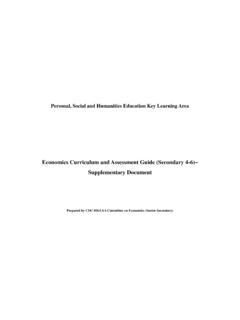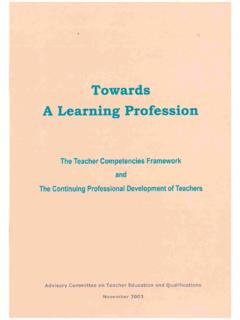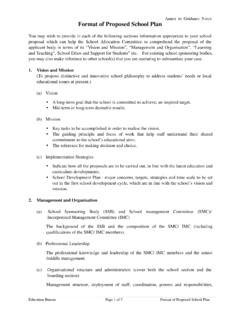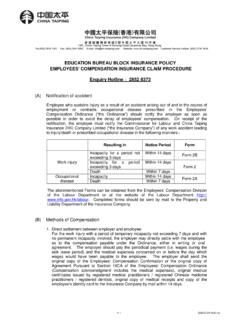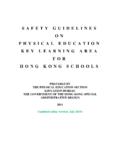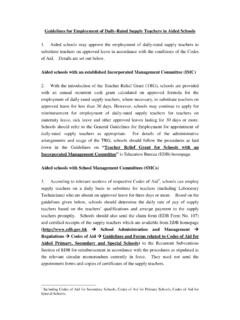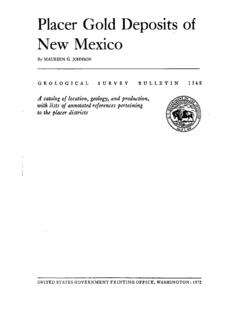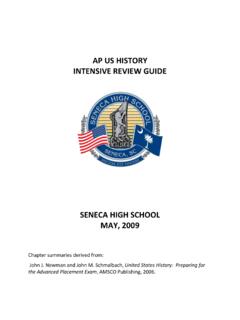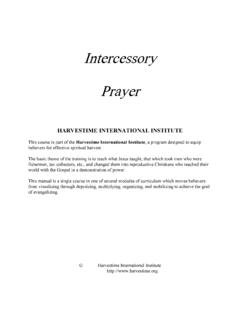Transcription of Theme Park - Home - Education Bureau
1 I Theme Park ii iii Contributors School of Hotel and Tourism Management, The Hong Kong Polytechnic University and PSHE Section, Curriculum Development Institute iv v Copyright The Government of the Hong Kong Special Administrative Region All rights reserved. The copyright of this manual belongs to the Government of the Hong Kong Special Administrative Region. Commercial use is strictly prohibited. Offenders will be liable to legal responsibility. Schools need not apply for permission to copy this manual in whole or in part for non-profit making educational or research purposes. All other uses should gain prior permission in writing from the Government of the Hong Kong Special Administrative Region.
2 Requests should be directed to the: Education Bureau 13/F, Room 1319, Wu Chung House 213 Queen s Road East, Wan Chai Hong Kong or by email to: vi Acknowledgement 1. "Clapperboard" courtesy of digitalart. Published on 20 April 2011. Stock photo - Image ID: 10038511 at 2. "Jupiter And The Satellite" courtesy of njaj. Published on 3 December 2014. Stock photo - Image ID: 100300238 at 3. "Line Of Roller Coaster Rail" courtesy of antpkr. Published Photo by antpkr. Published on 12 October 2012 Stock photo - Image ID: 100106338 at 4. "Mascot Cartoon" courtesy of Published on 25 February 2015. Stock photo - Image ID: 100312445 at 5. "Paper Weather Icon" courtesy of SweetCrisis. Published on 13 February 2013.
3 Stock photo - Image ID: 100139301 at 6. "Recycle Icon" courtesy of digitalart. Published on 24 July 2011. Stock photo - Image ID: 10051023 at 7. "Roller Coaster Rail" courtesy of antpkr. Published Photo by antpkr. Published on 13 December 2012 Stock photo - Image ID: 100126980 at (front cover) 8. "Target Audience" courtesy of sheelamohan. Published on 19 April 2011. Stock photo - Image ID: 10038289 at 9. "Travel Flat " courtesy of Sira Anamwong. Published on 13 August 2015. Stock photo - Image ID: 100351018 at 10. "Travel Flat " courtesy of Sira Anamwong. Published on 13 August 2015. Stock photo - Image ID: 100351019 at vii Module III - Destination Geography Theme Park viii Contents Page 1.
4 The fundamental concepts of Theme parks 10 Types of Theme park 12 The features of a Theme park 17 2. Factors contributing to the success of Theme parks 21 Overall attractiveness and visitors experiences 21 (I) Unique and interesting Theme 22 (II) Value for money / Variety of on-site attractions 23 (III) Clean and pleasant environment 24 (IV) Motivated and well-trained staff 26 (V) Good location 26 (VI) Quality and consistency in services and facilities 27 Adapt to market changes 28 (I) Senior segment 28 (II) Environmentally-friendly 29 (III) Edutainment 30 (IV) Interactive experiences 31 The management 35 (I) Pro-active management 35 (II) Strong financial resources and on-going investment 36 (III) Strong marketing team 36 (IV) Maintenance 37 Links 40 References 45 ix 10 1.
5 The Fundamental Concepts of Theme Parks Generally speaking, Theme parks can be defined as a subset of visitor attractions (Goeldner, 1999). Although Theme park is a subset of visitor attractions, there are attributes that distinguish Theme park from other kinds of visitor attractions in particular the entertainment attractions (Kemperman, 2000). The attributes are: (i) pay-one-price admission charge or pay-one-price attractions ( **admission charge for amusement parks is usually very minimal, and generally adopted a pay-as-you-go attractions pricing structure ); (ii) attractions are mostly man-made; (iii) high capital investments (Kemperman, 2000) ; and (iv) a combination of entertainment, food and beverage outlets, shops, and an environment that is different from that found outside its gates.
6 Definitions In view of the above unique attributes, definitions of Theme park written by the tourism industry and academic are presented: Industry s definition of a Theme park: 1. According to the International Association of Amusement Parks and Attractions (IAAPA), a Theme park is an amusement park that has themed 11 attractions, be it food, costumes, entertainment, retail stores and/or rides (IAAPA). 2. According to Forrec, the Theme park is a place of escape a chance to step away from the big burdens of the everyday. (Forrec, 2015) Academic definition of a Theme park: 1. Theme park as an aggregation of themed attractions, including architecture, landscape, rides, shows, foodservices, costumed personnel, and retail shops (Heo, 2009). 2.
7 Theme parks are extreme examples of capital intensive, highly developed, user-oriented, man modified, recreational environments (Pearce, 1988). 3. A Theme park is a destination in its own right, which combines entertainment, food and beverage and shops, and an environment that is different from that found outside its gates (Ap and Ho, 2009). Despite a number of different definitions of Theme park are presented, a common attribute is shared among them. Theme parks, in general, apply themes to provide visitors with interesting experiences different from daily life (Heo, 2009). 12 Types of Theme park The Theme is the main part of the visitors experience which is chosen when the park is planned to provide a focus for the design, development and operation of such a park.
8 Therefore, the selection of the Theme is extremely important to the operations of the park. In general, Theme parks attempt to create an atmosphere of another place and time, and usually emphasize one dominant Theme around which architecture, landscape, rides, shows, food services, costumed personnel, retailing are orchestrated (Kemperman, 2000). Although Theme parks were thought of offering visitors one major Theme , today most of the Theme parks contain multi-themes in terms of different attraction points or themed areas (Wong & Cheung, 1999). For example, Ocean Park Hong Kong major Theme is nature but it has multi-themes including wildlife animals and marine life. Theme parks can generally be classified into seven Theme types and related attributes as follows: Type of Theme park Attributes 1.
9 Adventure Excitement and action Frightening Mysterious Thrill rides 13 Type of Theme park Attributes 2. Futurism Advances in society and technology Discovery Exploration of science and technology Robotics Scientific Science fiction 3. International Flavours of the world International village Miniature replicas Scenic spots World expositions 4. Nature Animals Floral displays Horticultural gardens Landscaping Marine life Natural wonders Ocean Wildlife 5. Fantasy Animation Cartoon characters Childhood enchantment Children s play park Fairy tales Magic Make believe Myths and legends 14 Type of Theme park Attributes 6. History and culture Aboriginal Authentic Cultural heritage Cultural village gold rush Historic ambience 7.
10 Movies American Wild West shows Comedy Motion pictures Show business Stunt shows Types of Theme park (Source: Wong & Cheung, 1999) 15 Discussion Questions 1. Link to the website of TEA - Themed Entertainment Association , and using the information to give two examples for each types of Theme park listed in the below table: Type of Theme park Examples 1. Adventure 2. Futurism 3. International 4. Nature 5. Fantasy 6. History and culture 7. Movies 16 2. Refer to Photo A and Photo B below: How are the two pricing structures different from each other? 17 The Features of a Theme Park According to Kotler and Swarbrooke, there are three levels of product in a Theme park, and each level has its own features: Level 1: Core product; Level 2: Supporting (Tangible) product; and Level 3: Facilitating (Augmented) product.
